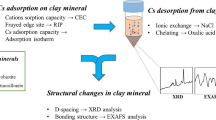Abstract
To better predict the fate and mobility of surfactants in the environment, sorption and desorption of a nonionic polyoxyethylene lauryl ether surfactant (Brij 35) by two smectites (Wyoming montmorillonite and Panther Creek smectite) and two interstratified mica-vermiculites (IMVs) were investigated by batch techniques, X-ray diffraction, and infrared spectroscopy. Maximum surfactant sorption by smectites ranged from 196 to 256 g kg−1, whereas the maximum sorption by the IMVs was indeterminate over the range of concentrations employed. Sorption by smectites was best described by the Langmuir model, but sorption by the IMVs showed an S-shaped isotherm, suggesting that cooperative sorption occurred. The surfactant was more readily desorbed from the IMVs than from the smectites in an initial wash with water. After two water washes, 65–75% of the initially sorbed surfactant was retained by the smectite, and 44–51% of the surfactant sorbed to the IMVs remained with the solid phase. In this study, basal spacing of the smectites increased to ≈17.5 Å near the sorption maximum, suggesting intercalation of surfactant molecules in the interlamellar regions of the clay. X-ray data also suggested that the surfactant molecules were oriented horizontally in the interlayer spaces. Greater surfactant sorption by the Casmectites gradually diminished the intensity of the 1630 cm−1 infrared band dues to hydration water, indicating that some water had been displaced by the surfactant. The surfactant was also sorbed by the IMV clays, but only on external surfaces and probably via interactions of micelles with the solid phase.
Similar content being viewed by others
References
Bailey, F.E. and Koleske, J.V. (1976) Polyethylene-oxide. Academic Press, London, 176 pp.
Brown, D.G. and Jaffe, P.R. (2001) Spectrophotometric assay of POE nonionic surfactants and its application to surfactant sorption isotherms. Environmental Science and Technology, 35, 2022–2025.
Chin, Y.P., Kimble, K.D. and Swank, CR. (1996) The sorption of 2-methylnapthalene by Rossburg soil in the absence and presence of nonionic surfactant. Journal of Contaminant Hydrology, 11, 83–94.
Choy, W.K. and Chu, W. (2001) The modeling of trichloro-ethene photodegradation in Brij 35 surfactant by two-stage reaction. Chemosphere, 44, 211–215.
Deng, Y., Dixon, J.B. and White, G.N. (2003) Intercalation and surface modification of smectite by two non-ionic surfactants. Clays and Clay Minerals, 51, 150–161.
Fuerstanau, D.W. (1970) Interfacial processes in mineral/water system. Pure and Applied Chemistry, 24, 135–164.
Gast, R.G. (1977) Surface and colloid chemistry. Pp. 27–73 in: Minerals in Soil Environments (J.B. Dixon and S.B. Weed, editors). Soil Science Society of America, Madison, WI.
Giles, C.H., MacEwan, T.H., Nakhwa, S.N. and Smith, D. (1960) Studies in adsorption. Part XI. A system of classification of solution adsorption isotherms and its use in diagnosis of adsorption mechanisms and in measurements of specific surface areas of solids. Journal of the Chemical Society, London, 3973–3993.
Krogh, K.A., Halling-Sørensen, B., Mogensesn, B.B. and Vejrup, K.V. (2003) Environmental properties and effects of nonionic surfactant adjuvants in pesticides: a review. Chemosphere, 50, 871–901.
Laird, D.A., Dowdy, R.H. and Munter, R.C. (1991) Suspension nebulization analysis of clays by inductively coupled plasma-atomic emission spectroscopy. Soil Science Society of America Journal, 55, 274–278.
Lee, M. and Fountain, J.C. (1999) The effectiveness of surfactants for remediation of organic pollutants in the unsaturated zone. Journal of Soil Contamination, 8, 39–62.
McBride, M.B. (1994) Environmental Chemistry of Soils. Oxford University Press, 406 pp.
Noordman, W.H., Brusseau, M.L. and Janssen, D.B. (2000) Adsorption of a multi-component rhamnolipid surfactant to soil. Environmental Science and Technology, 34, 832–838.
Ottewil, R.H. (1967) Effects of nonionic surfactants on the stability of dispersion. Pp. 627–680 in: Nonionic Surfactants (M.J. Schick, editor). Marcel Dekker, Inc., New York.
Parfitt, R.L. and Greenland, D.J. (1970) Adsorption of poly(ethylene glycols) on clay minerals. Clay Minerals, 8, 305–315.
Penneil, K.D., Abriola, L.M. and Weber Jr., W.J. (1993) Surfactant-enhanced solubilization of residual dodecane in soil columns. 1. Experimental investigation. Environmental Science and Technology, 27, 3322–3340.
Pinto, L.J. and Moore, M.M. (2000) Release of polycyclic aromatic hydrocarbons from contaminated soils by surfactant and remediation of this effluent by penicillium spp. Environmental Toxicology and Chemistry, 19, 1741–1748.
Rodriguez-Cruz, M., Sanchez-Martin, M.J. and Sánchez-Camazano, M. (2004) Enhanced desorption of herbicides sorbed on soils by addition of Triton X-100. Journal of Environmental Quality, 33, 920–929.
Rosch, M. (1967) Configuration of the polyethylene chain in bulk. Pp. 753–792 in: Nonionic Surfactants (M.J. Schick, editor). Marcel Dekker, Inc., New York.
Shen, Y. (2001) Preparations of organobentonite using nonionic surfactants. Chemosphere, 44, 989–995.
Sheng, G., Xu, S. and Boyd S.A. (1999) A dual function organoclay sorbent for lead and chlorobenzene. Soil Science Society of America Journal, 63, 73–78.
Somasundaran, P., Snell, E.D. and Xu, Q. (1991) Adsorption behavior of alkylarylethoxylated alcohols on silica. Journal of Colloid and Interface Science, 144, 165–173.
Theng, B.K.G. (1982) Clay-polymer interactions: Summary and perspectives. Clays and Clay Minerals, 30, 1–10.
Willumsen, P.A. and Arvin, E. (1999) Kinetics of degradation of surfactant-solubilized fluoranthene by a sphingomonas paucimobilis. Environmental Science and Technology, 33, 2571–2578.
Xu, Q., Vasudevan, T.V. and Somasundaran, P. (1991) Adsorption of anionic-nonionic and cationic-nonionic surfactant mixtures on kaolinite. Journal of Colloid and Interface Science, 142, 528–534.
Xu, S. and Boyd, S.A. (1995) Cationic surfactant sorption to a vermiculite subsoil via hydrophobic bonding. Environmental Science and Technology, 29, 312–320.
Yuan, C. and Jafvert, C.T. (1997) Sorption of linear alcohol ethoxylate surfactant homologs to soils. Journal of Contaminant Hydrology, 28, 311–325.
Zhu, L. and Feng, S. (2003) Synergistic solubilization of polycyclic aromatic hydrocarbons by mixed anionic-nonionic surfactants. Chemosphere, 53, 459–467.
Author information
Authors and Affiliations
Corresponding author
Rights and permissions
About this article
Cite this article
Sonon, L.S., Thompson, M.L. Sorption of a Nonionic Polyoxyethylene Lauryl Ether Surfactant by 2:1 Layer Silicates. Clays Clay Miner. 53, 45–54 (2005). https://doi.org/10.1346/CCMN.2005.0530106
Received:
Revised:
Published:
Issue Date:
DOI: https://doi.org/10.1346/CCMN.2005.0530106




